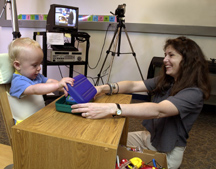 Purdue News
Purdue News
 Purdue News
Purdue News

|
|
August 2000 Researchers look at brain and behavior
|

|
"These findings indicate that as a baby learns a new skill, such as walking, the brain appears to reorganize itself, resulting in a temporary developmental step backward," says Daniela Corbetta, a professor of kinesiology and health science and director of Purdue's Infant Motor Development Laboratory.
Corbetta's findings are based on her observations of the development of hand preference and major motor skills such as crawling and walking.
"It has been well-documented since the 1940's that infants return to two-handed reaching and grabbing for a period of time even though single-handed reaching has been mastered for several months, but until now there has never been a documented explanation for why it happens."
Corbetta, who also holds an academic appointment in Purdue's Department of Psychological Sciences, set out to document at least one explanation by observing nine babies beginning at seven and eight months of age until they started to walk on their own.
"We presented each baby with a series of small, colorful objects at the midline and all of them were reaching for it with one hand until they began to walk," Corbetta explains. "Once they started walking, they all reverted to bi-manual reaching for a period of time."
Corbetta also presented the infants with a box from which they had to retrieve a small toy and the results were persistent.
"Prior to the onset of walking, the babies consistently opened the box with one hand, but after they began walking they switched back to two hands," she explains. "So this was not just happening with one task, it was happening across all the tasks we gave them."
Corbetta surmises that the process of learning to walk requires a great deal of postural reorganization, where many muscles are being used in a new way. The manner in which the brain processes this new activity temporarily alters the previously mastered reaching tendencies.
"In this case, the babies went back to bi-manual reaching because they were learning to walk," she says.
The study then followed the babies a little further to see when one-handed reaching would return.
"When they begin to walk, the arms are used for postural balance, and it is not uncommon for babies to hold their hands at shoulder-height or even higher in the first few weeks," Corbetta says. "As their balance improves and they gain greater postural control, the arms start to come down. We saw the return of one-handed reaching coincide with the lower arm positions."
Corbetta became interested in the subject while researching the development of hand preference in infants. Current literature suggests that toddlers will show a definite preference toward right- or left-handedness around three years of age, but before that their preferences can change several times.
"Parents regularly report that it is difficult to tell whether their child is leaning toward right- or left-handedness because they switch back and forth so often once they've mastered one-handed reaching," Corbetta says. "It's likely that these instabilities are linked to new-skill learning. We know babies learn a lot of complex skills in a very short period of time, but far less is known about how their brains process and store that accumulating information."
In an earlier study published in 1999 in the journal Developmental Psychobiology, Corbetta observed the reaching and non-reaching movements of four infants on a weekly basis from age three weeks to one year, and then compared those patterns of lateral biases to their hand-preference at age three.
What she found was that fluctuations in the babies' hand preferences appeared to correspond with the onset of a new sensory motor skill, such as sitting up alone, crawling or walking.
"I began to suspect that crawling and other skills actually interfered with their previous lateral preferences to reach and grab," Corbetta explains.
Those observations prompted her to investigate the reaching patterns of infants as they learned to crawl and walk.
"There has been a lot of research on individual behaviors, but we know far less about how various behaviors affect each other. These results seem to indicate that the sensory motor system is re-organizing as new skills are learned."
Corbetta presented her most recent research results at the biennial meeting of the Society for Research in Child Development in the spring of last year and at the European Conference on Developmental Psychology last fall. She is now completing the laboratory sessions on a new study in which babies' reaching patterns have been recorded through both crawling and walking.
"I think these studies show strong evidence that development is not continuous, which is an important idea that has been tossed around by experts in the field for quite awhile, but until now we really haven't had any data to explain where developmental discontinuities came from," Corbetta explains. "When examining multiple developing skills, this gives the big picture a completely different look."
Source: Daniela Corbetta, (765) 494-5827; dcorbet@purdue.edu
Writer: Sharon A. Bowker, (765) 494-9723, sbowker@purdue.edu
Purdue News Service: (765) 494-2096; purduenews@purdue.edu
PHOTO CAPTION:
Purdue University professor Daniela Corbetta works with 10-month-old Collin Smith of West Lafayette. Collin has been coming to Purdue's Infant Motor Development Laboratory since he was six months old so Corbetta can record changes in his reaching patterns during both the onset of crawling and the onset of walking. (Purdue News Service Photo by David Umberger)
A publication-quality photograph is available at the News Service Web site and at the ftp site. Photo ID: Corbetta.babybrain
 To the Purdue News and Photos Page
To the Purdue News and Photos Page